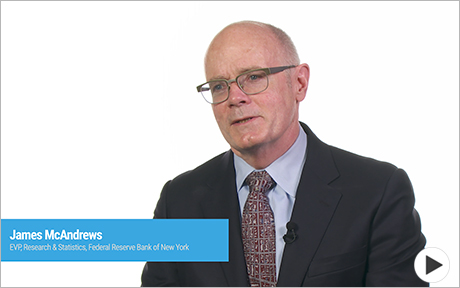The Effect of Exchange Rate Shocks on Domestic Prices

Mary Amiti, Oleg Itskhoki, and Jozef Konings Changes in exchange rates directly affect import prices. Since the beginning of 2014, the U.S. dollar has strengthened by 17 percent against the currencies of its major trading partners while import prices have fallen by 4 percent. The pass-through from exchange rates into import prices in the United […]
How the Fed Smoothed Quarter‑End Volatility in the Fed Funds Market
The federal funds market is an important source of short-term funding for U.S. banks.
Happy Fifth Birthday, LSE!

When we launched our research blog five years ago this week, we didn’t expect to set any internet traffic records while writing about economics. Still, we saw that a blog would be a good way to build familiarity with our research and policy analysis, and to share the expertise of our staff when it’s relevant to issues in the public eye. As I said back at the birth, our goal was to deliver “lively, clear, and analytically sound” posts and, in that, I think we have succeeded.
Upstate New York Job Growth: The Bad News Is that the Good News Was Wrong
What Tracks Commodity Prices?

Various news reports have asserted that the slowdown in China was a key factor driving down commodity prices in 2015. It is true that China’s growth eased last year and, owing to its manufacturing-intensive economy, that slackening could reasonably have had repercussions for commodity prices. Still, growth in Japan and Europe accelerated in 2015, with the net result that global growth was fairly steady last year, casting doubt on the China slowdown explanation. An alternative story relies on the strong correlation between the dollar and commodity prices over time. A simple regression shows that both global growth and the dollar track commodity prices, and in this framework, it is the rise of the dollar that captures last year’s drop in commodity prices. Thus a forecast of stable global growth and an unchanged dollar suggests little change in commodity prices in 2016.
Banking Deserts, Branch Closings, and Soft Information
U.S. banks have shuttered nearly 5,000 branches since the financial crisis, raising concerns that more low-income and minority neighborhoods may be devolving into “banking deserts” with inadequate, or no, mainstream financial services.
Hey, Economist! How Well Do We Weather Snowstorms?
In a Q&A interview, the New York Fed’s Jason Bram sheds light on how economists measure the cost of a snowstorm.
Would Monetary Tightening Increase Bank Wholesale Funding?
Dong Beom Choi and Hyun-Soo Choi The recent financial crisis clearly revealed that the reliance of banks on short-term wholesale funding critically increased their funding liquidity risks; during market disruptions, it becomes more likely that banks will be unable to roll over those funds and will hence be forced to fire-sell illiquid assets and possibly […]












 RSS Feed
RSS Feed Follow Liberty Street Economics
Follow Liberty Street Economics